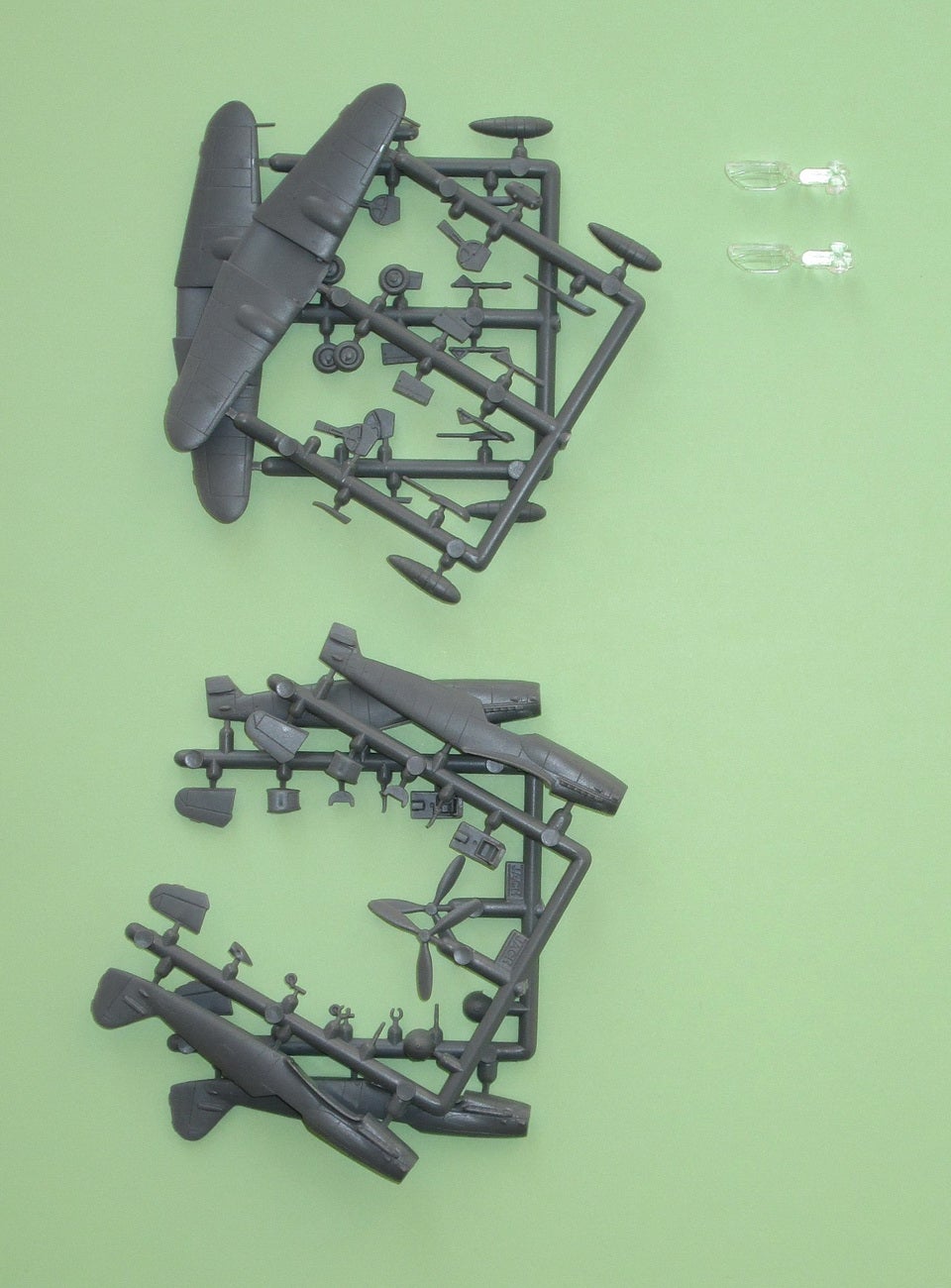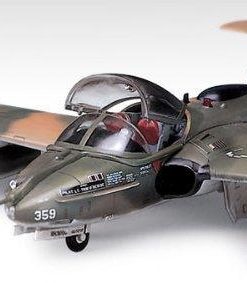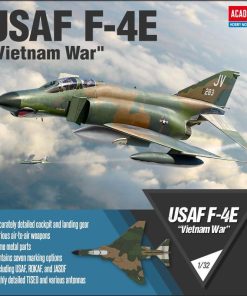Mark I 1/144 Messerschmitt Bf109G10 Late Gustav Fighter (2 in 1) Kit Estimated Processing Time: 2-3 Business Days
$ 23,99 $ 14,39
 The Messerschmitt Bf 109 was a German fighter aircraft designed in the mid-1930s and it represented the first modern fighter of the era. Originally conceived as an interceptor, later models were developed to fulfill various roles, such as bomber escort, the fighter-bomber, day and night fighter, ground-attack or reconnaissance. Various armament modifications evolved in service, using pre-packaged or field kits. The aircraft was of all-metal monocoque construction, featuring an enclosed canopy and a retractable landing gear.
The Messerschmitt Bf 109 was a German fighter aircraft designed in the mid-1930s and it represented the first modern fighter of the era. Originally conceived as an interceptor, later models were developed to fulfill various roles, such as bomber escort, the fighter-bomber, day and night fighter, ground-attack or reconnaissance. Various armament modifications evolved in service, using pre-packaged or field kits. The aircraft was of all-metal monocoque construction, featuring an enclosed canopy and a retractable landing gear.
The G-series aircraft were introduced in mid-1942. The initial variants differed only in minor details from its predecessor, the Bf 109F, most notably in the more powerful engine. Except for some early airplanes, the bulk of Bf 109G-10s were fitted with DB 605D engines and featured the Erla clear-view canopy, large main wheels with corresponding large oblong wing bulges, deeper oil cooler under the nose and tall tail fin.
The first Bf 109G-10s appeared in service in November 1944 and the following variants were produced: G-10 light fighter (with two MG 131 guns and a single MG 151/20 gun in the nose), G-10/R2 recce fighter, G-10/R6 bad-weather fighter and G-10/U4 fighter (equipped with an engine-mounted MK 108 cannon). In total, about 2,600 aircraft were produced by Erla, Messerschmitt, WNF and Diana factories.
The Bf 109 was the most produced fighter aircraft in aviation history, and besides the German Luftwaffe, it served in many other air forces and gallantly fought in all aerial combats of WWII.
Color schemes included in the kit:
1) Messerschmitt Bf 109G-10/U4 (WNF-built), Black 21 (W.Nr. 610783), 7./JG 52, Luftwaffe, Neubiberg airfield, Germany, May 1945
2) Messerschmitt Bf 109G-10/R6 (Erla-built), Yellow 11 (W.Nr. 152xxx), JG 52, Luftwaffe, Deutsch Brod airfield, Bohemia-Moravia Protectorate, May 1945
3) Messerschmitt Bf 109G-10/U4 (Diana-built), White 24 (W.Nr. 612762), Jasta 5 d. ROA (Russian Liberation Army) ’Oberst Kazakov’, Fliegerregiment der Luftwaffe der ROA, Deutsch Brod airfield, Bohemia-Moravia Protectorate, March-May 1945
4) Messerschmitt Bf 109G-10/U4 (Diana-built), Yellow 12 (W.Nr. 612769), 101. ’Puma’ Vadászezred (Fighter Regiment), Royal Hungarian Air Force (Magyar Királyi Honvéd Légier’), Veszprém airfield, spring 1945
Two injection-molded kits are supplied in this box and each kit contains 26 parts and one clear part (the cockpit canopy). A comprehensive decal sheet is included.
Professionally packed and fast shipping
Because of our long-standing partnership with UPS, FedEx, DHL and many other top global carriers we can provide an array of shipping options. Our warehouse staff are highly skilled and will pack your products according to our exact and precise specifications. Your products will go through an extensive inspection and will be properly secured before they are shipped. We ship to thousands clients every day in a variety of countries. Our determination to be the biggest online retailer around the globe is evident by this. Warehouses and distribution centers are located throughout Europe and the USA.
Orders with more than one item are given processing time in accordance with the item.
Before shipping, we will examine the items ordered thoroughly before sending the items. Today, the majority of orders will be delivered within 48 hours. The expected delivery time will be between 3 and 7 days.
Returns
Due to the multiple parties involved which include the factory as well as the warehouse, we are unable to completely manage our stock. So the actual stock may change at any time. Be aware that it's possible for your order to become unavailable even after you have placed the order.
Our policy is valid for 30 days. However, if thirty days have passed after you bought your product, we are unable to provide a refund or exchange.
Your item should be in the original packaging and in good condition. It must also not be used. It should also be in the original packaging.
Related products
MODEL AIRCRAFT
MODEL AIRCRAFT
Academy Aircraft 1/144 B52H 20th BS Buccaneers USAF Subsonic Strategic Bomber Kit OUT OF STOCK
MODEL AIRCRAFT
MODEL AIRCRAFT
MODEL AIRCRAFT
MODEL AIRCRAFT
Academy Aircraft 1/72 EA-18G VAQ141 “Shadow Hawks” Fighter Kit Estimated Shipping: 3-4 Business Days
MODEL AIRCRAFT
Academy Aircraft 1/48 P40N USAAF Fighter Battle of Imphal Kit Estimated Shipping: 3-4 Business Days
MODEL AIRCRAFT
Academy Aircraft 1/72 B29A Enola Gay/Bockscar Bomber Kit Estimated Shipping: 2-3 Business Days
MODEL AIRCRAFT
Academy Aircraft 1/72 A37B Dragonfly Aircraft Kit Estimated Shipping: 3-4 Business Days
MODEL AIRCRAFT
Academy Aircraft 1/72 AH-64D Block II Late Version US Army Kit Estimated Shipping: 3-4 Business Days
MODEL AIRCRAFT
MODEL AIRCRAFT
Academy Aircraft 1/32 F4E USAF Fighter Vietnam War Kit Estimated Shipping: 3-4 Business Days
MODEL AIRCRAFT
MODEL AIRCRAFT
Academy Aircraft 1/48 F8F1/2 USS Tarawa USN Fighter Kit Estimated Shipping: 3-4 Business Days



























































